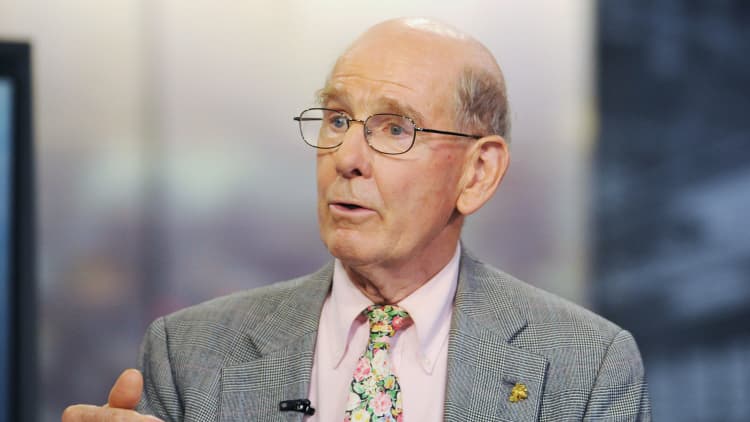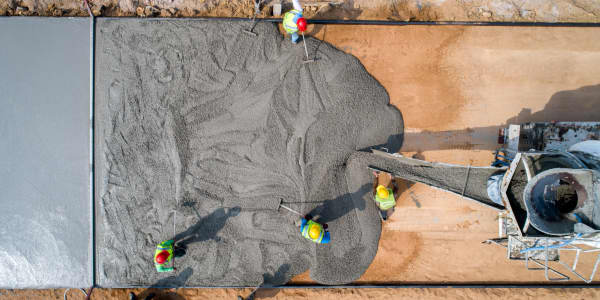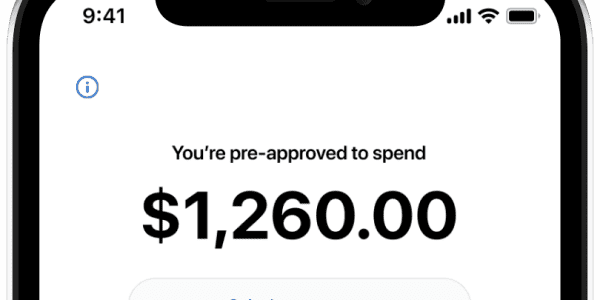Companies are in desperate need of workers across the country as the economic reopening collides with a tight labor market, but the boom in manual labor job wage growth pre-dates the pandemic.
Donna Kauffman, co-owner of a landscaping design and construction company in Colleyville, Texas, said a tightened labor market has pushed her starting wage up to $13.75 per hour, compared to lower wages in previous years.
Economic forecasters like Gary Shilling have been watching blue-collar and manual service wages trend upwards for the last several years, growing at a faster rate than wages for white-collar jobs and reversing a trend that had been in place throughout the past 30 years, according to data from the U.S. Bureau of Labor Statistics.
"In general, on the blue collar level, you're probably going to see higher real incomes," Shilling recently told CNBC.
Shilling says "labor share" — the amount of GDP paid out in wages, salaries, and benefits — which has been in decline for decades is trending higher, while "capital share" — the amount of national income from invested capital — is trending down.
For workers in blue-collar industries such as construction, transportation and manufacturing, and workers in manual service sectors including food service, leisure, hospitality and beauty and health-care services, they've seen the highest jump in wages in recent years. Those wages continue to increase post-pandemic.
The economy will depend on manual labor jobs to reopen, according to Gad Levanon, head of the Labor Market Institute at the Conference Board, and the recent rise in wages is due to the supply constraint of workers in these industries, as the country continues to face repercussions of the ongoing pandemic.
The June nonfarm payroll report showcased a rise in average hourly wages across all industries, with a 343,000 employment increase in leisure and hospitality jobs, with over half being food service workers. But employment in areas like construction, transportation and manufacturing remained low.
Levanon says it is taking longer to find workers for these industries, despite the rise in wages, because these positions are usually filled with workers from lower socioeconomic statuses, who continue to be impacted by pandemic. These jobs require face-to-face interaction and hands-on abilities that pose potential health risks to workers, and many of these workers either will not or cannot return to work due to factors like inaccessibility to child care and continued federal unemployment benefits.
Discussion around why workers are not returning to work remains highly contested. Some say unemployment benefits deter workers, others say benefits don't play a role. Some say increasing vaccination rates will encourage workers back, but others feel risks are still high among vulnerable populations.
Some experts think the wage gains are here to stay, and it will be up to companies to offset the cost of wages as more workers return.
"America is first and foremost a service economy," said Daniel Zhao, senior economist at Glassdoor. "So as the economy reopens, I do expect to see more demand for in-person services and this factors into the coming boom in service roles and work."
Sports apparel company Under Armour is boosting its minimum hourly wage for its retail and distribution workers from $10 to $15, while restaurants like McDonald's and Chipotle are hiking up their wages, and in April, the White House increased the minimum wage to $15 for federal contractors, including jobs for construction workers and mechanics.
Zhao says when companies like McDonald's and Chipotle raise their minimum wages, it means they perceive labor shortage and wage inflation as long-term problems.
"If they perceived this as just a temporary, pandemic-time shortage, then they would just rely on one-time bonuses or hiring bonuses," Zhao said. "But the fact that they're raising wages indicates there are these employers who believe challenges in finding workers will last for a significant amount of time."
Workers willing to do manual jobs declining
While every industry is currently suffering from labor constraints, Kauffman said she's seen the steady decline of workers willing to do hands-on labor for the last 20 years.
Forty-four percent of companies currently have openings for skilled workers, according to a June survey from the National Federation of Independent Business, and 66% of construction companies reported not having enough skilled or qualified workers to hire.
One reason worker aren't returning to these jobs quickly is because they have bargaining power, says Gregory Daco, chief U.S. economist at Oxford Economics. Employers have to continue to meet higher wage requirements and employment conditions in order to attract these workers back.
The labor market for manual labor jobs has been shrinking from the years before the pandemic started, according to Levanon, as older generations retire and there are less people to work these jobs. That trend will remain in place in the years ahead.
"Baby boomers that are retiring are people with less education who work these blue-collar and manual service jobs," Levanon said. "And most of the young generation that is replacing them is more educated and less willing to work in those types of jobs."
Kauffman said her landscaping company used to hire young adults, either high school students or young adults who didn't pursue college, but gradually, as high schools in her area started pushing college onto more students and started shutting down agricultural education programs, she has lost potential workers.
Daco says that while desire among workers to perform these tasks is an issue, there are more direct reasons for the labor shortage and wage gains in blue-collar and manual service jobs. There are enough people, on average, to work these jobs, he says, looking at the 6.4 million people who are not currently working but would like a job, according to the June nonfarm payroll report.
Skills gaps and a lack of jobs being located in the places where workers live contribute to hiring difficulties.
"You have workers, but they may not be in the right place at the right time," Daco said. "You may have rural areas that need people to work in the service, leisure or hospitality sector but fewer people want to live there."
Infrastructure spending can push wages higher
While debate continues within Congress and the White House about a tentative federal spending and infrastructure bill, bipartisan support for bolstering physical infrastructure across the country, including additions and expansions to roads, bridges and highways, should keep demand high for blue-collar work and wage pressure on employers.
The details of any specific plan passed by Congress are key, but Levanon says companies will continue to face extremely difficult recruiting barriers for construction workers and manual laborers.
As federal spending plans become clearer, Daco expects increased pressure to fill these jobs pushing wages up, but not suddenly. He forecasts a more gradual increase happening closer to the middle of 2022, as infrastructure plans become reality. And while current wages are a starting point for the future, he does not see the as the starting point of prolonged spike in the blue-collar wage boom.
"I don't think this is the onset of a wage inflation spiral, in that wages will continue to increase at the same pace as it has been indefinitely," he said.
—CNBC's MacKenzie Sigalos contributed to this report







